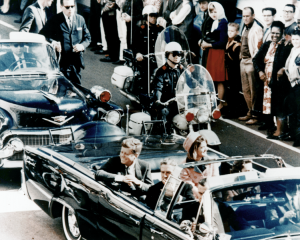November 21, 2013

President John F. Kennedy in the motorcade through Dallas shortly before his assassination on Nov. 22, 1963. (Photo credit: Walt Cisco, Dallas Morning News)
Media specials are on tap for the 50th anniversary of John F. Kennedy’s murder, but none will explore the troubling new evidence that has been declassified in recent years – and that undercuts the Official Story of the Lone Gunman.
In late 1991, film director Oliver Stone released JFK, his film about the investigation of the murder of President John F. Kennedy by New Orleans District Attorney Jim Garrison. To say the film was controversial does not begin to describe the furor which surrounded its reception. Six months before the film was in theaters, stories began to appear in large newspapers criticizing a film no one had seen yet.
When the film was finally shown, there was an interesting dichotomy. Whereas most of the film critics liked it, editorials and news stories about the movie attacked it. One critic actually lost her job over a positive review of the film.
But the film did two things relevant to the state of the evidence in the matter of President Kennedy’s assassination on Nov. 22, 1963. At the end of his film, Stone had shown a title card saying that the files of the House Select Committee on Assassinations (HSCA) had been classified until the year 2029.
Embarrassed – and faced with public outrage – Congress held hearings. Many people testified including Stone, and the last chief counsel of the HSCA, Robert Blakey. As a result, the Assassination Records Review Board (ARRB) was created, tasked with finding and releasing all documents held by public and private entities in America concerning the murder of President Kennedy. Eventually, two million pages of classified files were open to the public.
The second thing the film did was arouse the curiosity of many people who were not aware of the evidentiary problems that had haunted the Kennedy case for nearly 30 years. Stone’s film was the first time in over a decade that millions of Americans had been exposed to things like the Zapruder film, Oswald’s odd relationships with the FBI and CIA, his associations with right-wingers in Dallas and New Orleans, the investigative failings of the Warren Commission, the problems with the autopsy of President Kennedy, and much, much more.

No comments:
Post a Comment